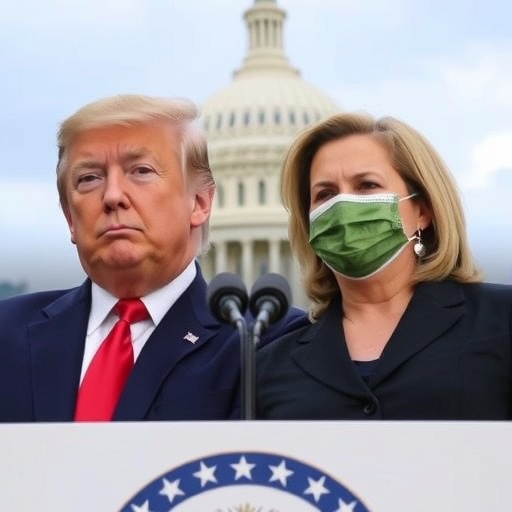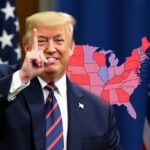US Government shutdown Deepens: Trump and Democrats Deadlocked Over Pandemic Health Care Subsidies
In a escalating partisan standoff that’s paralyzing the nation’s capital, the US Government shutdown has stretched into its 28th day, cementing its place as the second-longest in American history. President Donald Trump and Democratic lawmakers in Congress are locked in a bitter feud over funding for pandemic-era health care subsidies, leaving millions of federal workers without paychecks and essential services teetering on the brink. As frustration mounts across the country, moderate Democrats face mounting pressure to intervene and break the impasse before the economic fallout spirals further.
- Shutdown Surpasses Historic Milestones, Echoing 1990s Gridlock
- Pandemic Health Care Subsidies: The Flashpoint Dividing Trump and Democrats
- Trump’s Unyielding Position Fuels Democratic Backlash in Congress
- Moderate Democrats Eyed as Potential Bridge to Resolution
- Economic Ripples and Path Ahead: What Happens If the Standoff Persists
Shutdown Surpasses Historic Milestones, Echoing 1990s Gridlock
The current Government shutdown has now outlasted the 21-day closure of 2018-2019, which itself was a flashpoint during Trump’s first term. According to historical records from the Congressional Research Service, this shutdown rivals the infamous 1995-1996 standoff between President Bill Clinton and Republican Speaker Newt Gingrich, which lasted 21 days and cost the economy an estimated $1.4 billion in today’s dollars. But unlike those earlier disputes over budgets and welfare reform, today’s crisis centers on extending health care subsidies introduced during the COVID-19 pandemic to bolster Affordable Care Act marketplaces.
Federal agencies from the Department of Homeland Security to the National Parks Service remain partially operational, but non-essential functions are frozen. Over 800,000 federal employees are furloughed or working without pay, a figure that includes air traffic controllers, border patrol agents, and Smithsonian curators. “This isn’t just about politics; it’s about people,” said Sen. Lindsey Graham (R-SC), a Trump ally, in a recent Fox News interview. “Families are struggling while Washington plays games.”
Economists warn that the prolonged closure could shave 0.2% off GDP growth in the final quarter of 2023, per a report from the Bipartisan Policy Center. Stock markets have dipped 1.5% since the shutdown began, with investor anxiety focused on potential disruptions to tax refunds and veterans’ benefits come tax season.
Pandemic Health Care Subsidies: The Flashpoint Dividing Trump and Democrats
At the heart of the government shutdown lies a contentious debate over health care subsidies that were expanded under the American Rescue Plan Act of 2021 to make insurance more affordable amid the pandemic’s economic ravages. These subsidies, which cap premiums at 8.5% of income for millions of Americans, are set to expire at the end of the year unless Congress acts. Democrats, led by House Speaker Nancy Pelosi and Senate Majority Leader Chuck Schumer, insist on a clean extension bundled into a broader spending bill, arguing it would prevent 4 million people from losing coverage, according to Kaiser Family Foundation estimates.
President Trump, however, has vowed to veto any package that doesn’t include stricter work requirements for the subsidies and offsets through cuts to other social programs. In a fiery White House address last week, Trump declared, “We’re not going to reward dependency with endless handouts. The American people want real solutions, not more Washington waste.” His administration points to data showing that subsidy costs have ballooned to $60 billion annually, up from $40 billion pre-pandemic, and argues for reforms to ensure long-term sustainability.
The divide isn’t just ideological. Republicans in Congress contend that Democrats are using the subsidies as leverage to push through unrelated progressive priorities, like enhanced Medicaid funding for green energy transitions. A leaked memo from House Minority Leader Kevin McCarthy’s office revealed GOP demands for $10 billion in subsidy clawbacks tied to employment verification, a proposal Democrats have dismissed as a non-starter. “This is extortion,” Schumer tweeted on day 25 of the shutdown. “Families need health care now, not ideological purity tests.”
Public opinion polls reflect the growing rift. A recent Quinnipiac University survey found 58% of Americans blame both parties equally, but 62% of independents side with Democrats on preserving the health care subsidies, highlighting the political stakes for the 2024 midterms.
Trump’s Unyielding Position Fuels Democratic Backlash in Congress
President Trump‘s refusal to budge has intensified the Democrats’ resolve, transforming what began as routine budget talks into a full-blown constitutional crisis. Sources close to the White House say Trump views the shutdown as a bargaining chip to rally his base ahead of potential 2024 challenges, drawing parallels to his 2018-2019 wall funding fight. “The president is prepared to stand firm,” Press Secretary Kayleigh McEnany stated during a briefing. “Health care reform can’t wait for election-year politics.”
In Congress, the partisan lines are sharply drawn. Senate Republicans, holding a slim 52-48 majority, have blocked three Democratic attempts to pass a short-term funding resolution that would reopen the government while negotiations continue. Meanwhile, the House, under Democratic control, passed a bill last month extending the subsidies for two years without offsets, only for it to stall in the upper chamber. “This is amateur hour,” quipped Rep. Alexandria Ocasio-Cortez (D-NY) on social media, garnering over 1 million likes. “Trump’s ego is shutting down the government while people lose their homes.”
The human cost is mounting. Stories of furloughed workers lining up at food banks in Virginia and Maryland suburbs have gone viral, with one viral video of a Coast Guard officer explaining how he’s rationing groceries amassing 5 million views on TikTok. Labor unions, including the American Federation of Government Employees, have filed lawsuits demanding back pay, citing precedents from previous shutdowns. A federal judge in D.C. has scheduled a hearing for next week, which could add legal pressure on lawmakers.
Behind the scenes, bipartisan talks have fizzled. A group of five senators—three Republicans and two Democrats—met secretly last Tuesday but emerged without progress, according to Politico reporting. The impasse has also delayed critical appropriations for disaster relief in hurricane-hit states, irking even red-state governors who might otherwise support Trump.
Moderate Democrats Eyed as Potential Bridge to Resolution
As the government shutdown drags on, eyes are turning to a handful of moderate Democrats in swing districts who could tip the scales toward compromise. Figures like Sen. Joe Manchin (D-WV) and Rep. Henry Cuellar (D-TX), known for their centrist leanings, are under intense scrutiny from both parties. Manchin, facing reelection in a deep-red state, has publicly called for “common-sense reforms” to the health care subsidies, suggesting a phased extension tied to inflation adjustments.
“I’m not going to let partisanship hurt West Virginians,” Manchin said in a CNN appearance, hinting at willingness to negotiate with Trump on work requirements if Democrats concede on some green spending. Cuellar echoed this in a statement to local Texas media: “Families in my district can’t afford this chaos. We need to find middle ground now.” Advocacy groups like AARP are lobbying these moderates heavily, with over 10,000 petitions delivered to Capitol Hill urging protection for seniors reliant on subsidized plans.
Yet, the path forward is fraught. Progressive Democrats, including the Squad, have warned that any deal diluting the subsidies could fracture party unity, potentially costing votes in the House. On the Republican side, hardliners like Sen. Ted Cruz (R-TX) have threatened primary challenges to any GOP member who caves. A compromise bill floated by the Problem Solvers Caucus—a bipartisan group of 50 lawmakers—proposes a one-year subsidy extension with $5 billion in offsets from administrative efficiencies, but it lacks the votes to pass without leadership buy-in.
Whispers in Washington suggest a breakthrough could come if Congress ties the subsidies to a larger infrastructure package, blending Democratic priorities with Trump’s past support for big builds. But with Thanksgiving approaching and holiday travel strained by understaffed TSA agents, public pressure is building for action.
Economic Ripples and Path Ahead: What Happens If the Standoff Persists
The government shutdown‘s economic tentacles are reaching far beyond Washington, with small businesses delaying expansions due to uncertain federal contracts and credit rating agencies like Moody’s issuing warnings of a potential downgrade if the crisis exceeds 30 days. The US Chamber of Commerce estimates daily losses at $160 million, including impacts on tourism from closed national monuments and delayed FDA approvals for new drugs.
Looking forward, the stakes couldn’t be higher. If no deal is reached by December 1, when temporary funding for some agencies expires, the shutdown could balloon to affect 2 million workers. Bipartisan experts predict this could trigger a recessionary blip, especially with inflation hovering at 3.2% and supply chains still fragile post-pandemic. International allies, from the EU to Japan, have expressed concern over US instability, with the dollar weakening 0.8% against the euro since the impasse began.
Next steps hinge on upcoming negotiations. House Democrats have scheduled a vote on a discharge petition to force a funding bill to the floor, bypassing leadership—a rare move last used in 2015. Trump has invited key Congressional leaders to the White House for talks on Monday, signaling possible movement. Meanwhile, voter outreach campaigns by groups like MoveOn.org are ramping up, with ads blasting both Trump and Democrats for the chaos.
As the nation braces for potential escalation, the real question is whether cooler heads—or moderate voices—can prevail. With health care access for 13 million Americans hanging in the balance, the clock is ticking toward what could be a defining moment in American governance.








